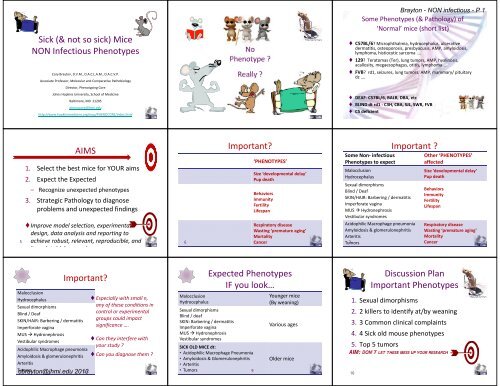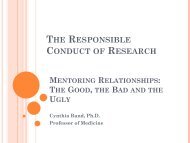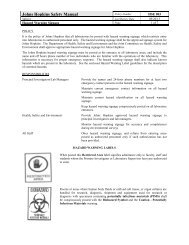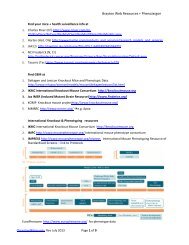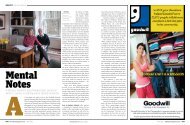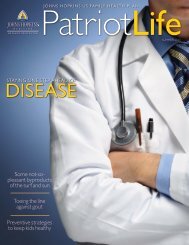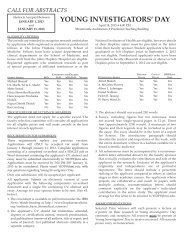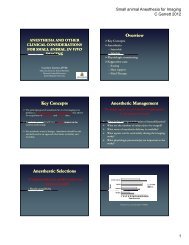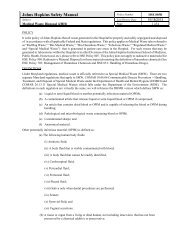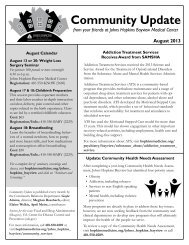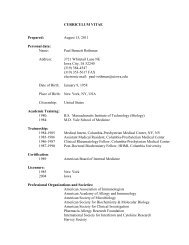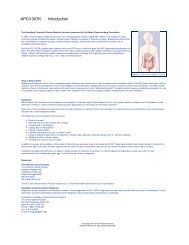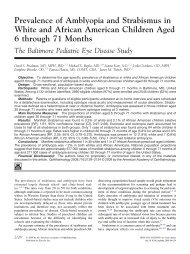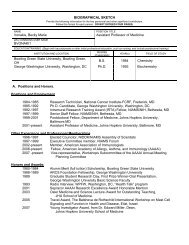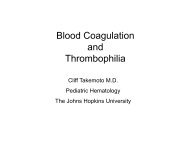Sick - Johns Hopkins Medicine
Sick - Johns Hopkins Medicine
Sick - Johns Hopkins Medicine
You also want an ePaper? Increase the reach of your titles
YUMPU automatically turns print PDFs into web optimized ePapers that Google loves.
<strong>Sick</strong> (& not so sick) Mice<br />
NON Infectious Phenotypes<br />
Cory Brayton, D.V.M., D.A.C.L.A.M., D.A.C.V.P.<br />
Associate Professor, Molecular and Comparative Pathobiology<br />
No<br />
Phenotype ?<br />
Really ?<br />
Brayton - NON infectious - P 1<br />
Some Phenotypes (& Pathology) of<br />
‘Normal’ mice (short list)<br />
C57BL/6? Microphthalmia, hydrocephalus, ulcerative<br />
dermatitis, osteoporosis, presbyacusis, AMP, amyloidosis,<br />
lymphoma, histiocytic sarcoma .…<br />
129? Teratomas (Ter), lung tumors, AMP, hyalinosis,<br />
acallosity, megaesophagus, otitis, lymphoma …<br />
FVB? rd1, seizures, lung tumors, AMP, mammary/ pituitary<br />
dz ….<br />
Director, Phenotyping Core<br />
<strong>Johns</strong> <strong>Hopkins</strong> University, School of <strong>Medicine</strong><br />
Baltimore, MD 21205<br />
phenocore@jhmi.edu<br />
http://www.hopkinsmedicine.org/mcp/PHENOCORE/index.html<br />
DEAF‐ C57BL/6, BALB, DBA, etc<br />
BLIND dt rd1 ‐ C3H, CBA, SJL, SWR, FVB<br />
C5 deficient<br />
4<br />
5<br />
AIMS<br />
1. Select the best mice for YOUR aims<br />
2. Expect the Expected<br />
– Recognize unexpected phenotypes<br />
3. Strategic Pathology to diagnose<br />
problems and unexpected findings<br />
Improve model selection, experimental<br />
design, data analysis and reporting to<br />
achieve robust, relevant, reproducible, and<br />
’t l t bl ’ h<br />
6<br />
Important?<br />
‘PHENOTYPES’<br />
Size ‘developmental delay’<br />
Pup death<br />
Behaviors<br />
Immunity<br />
Fertility<br />
Lifespan<br />
Respiratory disease<br />
Wasting ‘premature aging’<br />
Mortality<br />
Cancer<br />
Important ?<br />
Some Non‐ infectious<br />
Phenotypes to expect<br />
Malocclusion<br />
Hydrocephalus<br />
Sexual dimorphisms<br />
Blind / Deaf<br />
SKIN/HAIR: Barbering / dermatitis<br />
Imperforate vagina<br />
MUS Hydronephrosis<br />
Vestibular syndromes<br />
Acidophilic Macrophage pneumonia<br />
Amyloidosis & glomerulonephritis<br />
Arteritis<br />
Tumors 7<br />
Other ‘PHENOTYPES’<br />
affected<br />
Size ‘developmental delay’<br />
Pup death<br />
Behaviors<br />
Immunity<br />
Fertility<br />
Lifespan<br />
Respiratory disease<br />
Wasting ‘premature aging’<br />
Mortality<br />
Cancer<br />
X<br />
Important?<br />
Malocclusion<br />
Hydrocephalus<br />
Sexual dimorphisms<br />
Blind / Deaf<br />
SKIN/HAIR: Barbering / dermatitis<br />
Imperforate vagina<br />
MUS Hydronephrosis<br />
Vestibular syndromes<br />
Acidophilic Macrophage pneumonia<br />
Amyloidosis & glomerulonephritis<br />
Arteritis<br />
Tumors<br />
8<br />
cbrayton@jhmi.edu 2013<br />
Especially with small n,<br />
any of these conditions in<br />
control or experimental<br />
groups could impact<br />
significance ….<br />
Can they interfere with<br />
your study ?<br />
Can you diagnose them ?<br />
X<br />
Expected Phenotypes<br />
IF you look…<br />
Malocclusion<br />
Hydrocephalus<br />
Sexual dimorphisms<br />
Blind / deaf<br />
SKIN: Barbering / dermatitis<br />
Imperforate vagina<br />
MUS Hydronephrosis<br />
Vestibular syndromes<br />
SICK OLD MICE dt:<br />
• Acidophilic Macrophage Pneumonia<br />
• Amyloidosis & Glomerulonephritis<br />
• Arteritis<br />
• Tumors<br />
9<br />
Younger mice<br />
(By weaning)<br />
Various ages<br />
Older mice<br />
Discussion Plan<br />
Important Phenotypes<br />
1. Sexual dimorphisms<br />
2. 2 killers to identify at/by weaning<br />
3. 3 Common clinical complaints<br />
4. 4 <strong>Sick</strong> old mouse phenotypes<br />
5. Top 5 tumors<br />
AIM: DON’T LET THESE MESS UP YOUR RESEARCH<br />
10
X<br />
1. Some Sexual Dimorphisms<br />
Size growth curves = NICE DATA !<br />
• Are the GEM really smaller? Slower growing ?<br />
Anogenital distance –tough in younger<br />
• In utero influences<br />
Nipples –not in males<br />
Salivary glands – bigger in males<br />
• Acidophilic tubules<br />
Kidneys – bigger in females ? Males ?<br />
• Cuboidal parietal epithelium –male (>> female)<br />
Adrenal glands – bigger in females<br />
• X zone (vacuolar change in females)<br />
11<br />
1. Some Sexual Dimorphisms<br />
If they’re normal,<br />
what’s the big deal?<br />
Are there sexual dimorphisms in your data, or<br />
research endpoints ?<br />
ANALYZE Male & Female data separately<br />
ALSO CONSIDER: NOT having these may be an<br />
important phenotype<br />
12<br />
Brayton - NON infectious - P 2<br />
Sex and SIZE<br />
(+ Genetic Background)<br />
SIZE (body weight)<br />
M > F<br />
B6D2F1 ~ Hi?<br />
C3H/HeJ ~ lo<br />
Jax Phenome Database for<br />
physiological data by strain sex<br />
age protocol<br />
– Jax Pheno1<br />
– n = 5‐15<br />
– 6% fat diet NIH 316 Purina 5K52<br />
13<br />
♂<br />
♀<br />
Sexual Dimorphisms<br />
Which is Male? A or B ?<br />
Check<br />
Anogenital distance<br />
Nipples<br />
♀ ♂<br />
A B<br />
Sexing pups<br />
Nice pictures at<br />
http://www.thefunmouse.com/info/sexing.cfm<br />
Salivary Glands, associated Nodes<br />
Which is Male ?<br />
A<br />
A or B ?<br />
1. Submandibular<br />
2. Sublingual B<br />
3. Parotid<br />
(exorbital lacrimal)<br />
4. Lymph nodes<br />
14<br />
Nipples may be evident by about 6do 16<br />
A<br />
Tissues?<br />
Which is Male?<br />
B<br />
Tissue?<br />
Which is more likely to be male?<br />
A<br />
B<br />
A<br />
FEMALE<br />
Tissue?<br />
Which is Female ?<br />
B<br />
cbrayton@jhmi.edu 2013 17<br />
18<br />
19
X<br />
1. Sexual Dimorphisms<br />
Size Growth Curves = NICE DATA !<br />
Salivary glands, Kidneys, Adrenal glands etc<br />
Many More<br />
CONCLUSIONS:<br />
EXPECT THE EXPECTED –consider the unexpected<br />
ANALYZE Male & Female data separately<br />
Missing Dimorphisms may be a phenotype<br />
20<br />
X<br />
2. 2 Young Mouse Phenotypes<br />
to identify by / at weaning:<br />
1. Hydrocephalus<br />
• Later onset not evident at weaning<br />
E.g. sporadic in MRL etc.<br />
2. Malocclusion / Incisor overgrowth<br />
• Cull or trim<br />
• Breed??<br />
3. Microphthalmia<br />
• Expect this in C57BL – but it won’t kill them<br />
• Especially? Right eye in females<br />
21<br />
22<br />
Hydrocephalus<br />
Especially C57BL<br />
Brayton - NON infectious - P 3<br />
Malocclusion Phenotypes<br />
6g –6 weeks old<br />
Developmental delay’<br />
Early Death<br />
23<br />
X<br />
2. 2 Young Mouse Phenotypes<br />
to identify by / at weaning:<br />
1. Hydrocephalus<br />
2. Malocclusion / Incisor overgrowth<br />
3. Microphthalmia etc<br />
CONCLUSIONS:<br />
EXPECT THE EXPECTED –consider the unexpected<br />
DON’T let these kill your mice !<br />
Examine your mice<br />
– weaning is a good time to weigh them too<br />
24<br />
X<br />
3. 3 Common<br />
Clinical Complaints<br />
1) Skin Disease<br />
1) Barbering –more common<br />
2) Ulcerative Dermatitis –more serious<br />
3) Flakey skin ‐ in immunodeficient – discussed later<br />
4) Tumors – discussed later<br />
5) Mites – discussed frequently<br />
2) Abdominal distention<br />
1) Pregnancy <br />
2) Hydrometra mucometra pyometra<br />
3) Hydronephrosis (MUS)<br />
4) Neoplasia – effusion, organomegaly<br />
5) Effusion ‐ Neoplasia ? Heart or kidney disease?<br />
253) Neurologic signs<br />
1 st Clinical Complaint: Skin<br />
cbrayton@jhmi.edu 2013<br />
26<br />
Alopecia<br />
– Social phenomenon F > M<br />
– Vibrissae are important in<br />
some behavior tests …<br />
Skin Alopecia<br />
Barbering<br />
– Strain/sex specific<br />
patterns<br />
– Nibbled<br />
• Not plucked –<br />
ouch!<br />
– Vibrissae are<br />
important in<br />
some behavior<br />
tests …<br />
Kalueff 27 et al. 2006.<br />
129S1 ♂ NMRI ♂ C57Bl/6 ♂<br />
C57Bl/6 ♀ NMRI ♀ A/J ♂<br />
♂<br />
X<br />
SKIN: ulcerative dermatitis<br />
Mouse Ulcerative<br />
Dermatitis (MUD)<br />
• Interferes with a lot of research<br />
• Secondary phenotypes:<br />
Leukocytosis<br />
Lymphadenomegaly,<br />
Splenomegaly<br />
Amyloidosis,<br />
GN<br />
<strong>Sick</strong> mice<br />
Mortality<br />
C57BL > others<br />
28
2 nd Clinical Complaint<br />
Abdominal distention<br />
‘Pregnant x weeks… months ’<br />
Don’t ignore – NOT likely to have pups….<br />
Mouse gestation ~ 19‐21 d…..<br />
29<br />
30<br />
Hydronephrosis<br />
Probably / Usually Urinary obstruction<br />
– Has been called mouse urologic syndrome (MUS)<br />
Role of Genetic Background ?? Diet ?? Caging ??<br />
Polycystic kidneys are polycystic –<br />
– Multiple cysts, genetic<br />
Hydrometra, mucometra<br />
Progressive abdominal distention – weeks …<br />
– Imperforate vagina<br />
– Vaginal septa<br />
– Esp BALB/c, B6?<br />
– Note perineal bulge<br />
– Usually infertile<br />
– Pyometra –<br />
discussed later<br />
31<br />
Brayton - NON infectious - P 4<br />
X<br />
3 rd Clinical Complaint<br />
‘Neurologic’<br />
1. Paralysis, posterior paresis<br />
a) Neoplasia ‐ – discussed later<br />
b) Infectious demyelination –MHV, TMEV – discussed later<br />
c) Autoimmune demyelination – Induced –EAE etc<br />
d) Trauma, induced, muscular dystrophy? other<br />
2. Spinning, Rolling ‐ Dizzy, Vestibular<br />
a) Otitis –infectious– discussed later<br />
b) Arteritis – discussed later<br />
c) Infarct ~ stroke ?<br />
d) Trauma, induced, other<br />
3. Seizures (sudden death)<br />
a) FVB/N, DBA/2 other genetically susceptible<br />
32<br />
b) Other ‐ Induced? Chemical ? Genetic ?<br />
33<br />
'Neurologic‘ #1: Posterior Paresis<br />
Important phenotype?<br />
1. Neoplasia<br />
2. Infectious demyelination<br />
• MHV, TMEV, LDV<br />
3. Autoimmune demyelination<br />
• Induced –EAEetc<br />
4. Other Induced/experimental?<br />
• Iatrogenic? Trauma?<br />
• Muscular dystrophy?<br />
• other ?<br />
'Neurologic' #2: Rolling,<br />
Spinning, Head tilt (vestibular)<br />
Dizzy mice –GEM Model<br />
of vestibular syndrome?<br />
Consider:<br />
34<br />
1. Otitis?<br />
2. Arteritis ?<br />
3. Tumors?<br />
4. Other?<br />
Dumb mice?<br />
or Dizzy ?<br />
Vestibular Signs<br />
Rolling, turning<br />
Head Tilt<br />
Malacia, necrosis compatible<br />
with ischemia/infarct<br />
Southard & al 2007,<br />
2010<br />
Acute onset spinning<br />
(vestibular signs)<br />
death<br />
>12 mice of 2 Swiss<br />
stocks;<br />
1 source –local<br />
'Neurologic' #3: Seizures<br />
Important phenotype?<br />
In what strains do you expect seizures ??<br />
• FVB/N<br />
• DBA/2<br />
Consider<br />
• Tumors<br />
• Induced ‐ Kainic acid etc, surgical, IC inoculation<br />
cbrayton@jhmi.edu 2013<br />
35 36<br />
37
X<br />
38<br />
1. Skin Disease<br />
3. 3 Common<br />
Clinical Complaints<br />
2. Abdominal distention<br />
3. Neurologic signs<br />
CONCLUSIONS:<br />
EXPECT THE EXPECTED –consider the unexpected<br />
Examine your mice –<br />
Consider pathology to assess further<br />
Don’t let these mess up your research.<br />
X<br />
4. 4 <strong>Sick</strong> Old Mouse<br />
Phenotypes<br />
1. Amyloidosis – multisystem<br />
– Rule out glomerulonephritis<br />
2. Arteritis – multisystem<br />
3. Hyalinosis & Acidophilic macrophage pneumonia<br />
4. Neoplasia<br />
39<br />
– Sporadic – common on different genetic backgrounds<br />
– Histopathology to diagnose<br />
– MANY other conditions – but not so likely to contribute to<br />
morbidity mortality, e.g. :<br />
• Angiectasis, melanosis, mild mineralization, inflammatory infiltrates,<br />
pancreatic …<br />
Brayton - NON infectious - P 5<br />
Phenotype: wasting, 'premature aging'<br />
Amyloidosis, intestine<br />
Intestine (ileum) first & worst<br />
• Usually earlier & more severe than kidney, etc<br />
40<br />
Amyloidosis, kidney<br />
(pink stuff in glomeruli)<br />
Glomerulonephritis can be common &<br />
resemble glomerular amyloid<br />
(pink stuff in glomeruli)<br />
Amyloid is Congo Red POSITIVE / PAS negative<br />
GN usually is Congo Red negative / PAS POSITIVE<br />
H&E<br />
PAS<br />
41 42<br />
Mouse Amyloidosis<br />
Phenotypes<br />
Gut – Intestinal amyloid<br />
malabsorption<br />
Kidney – Glomerular amyloid protein loss<br />
Liver – Hepatic amyloid<br />
• Adrenal<br />
• Salivary glands<br />
• Tongue<br />
• Heart<br />
• Stomach<br />
• Testes<br />
43<br />
size, function<br />
Weight loss & Wasting<br />
‘Premature Aging’ phenotype<br />
e.g. in SAMP Senescence<br />
Accelerated Mice<br />
Mouse Amyloid<br />
2 types<br />
WERE COMMON complicators of chronic studies<br />
– less ‘clean’ conditions<br />
1. Reactive, Secondary, AA – SAA<br />
• SAA serum amyloid A component<br />
Acute phase response protein<br />
• chronic immune stimulation –GI, kidney, spleen<br />
2. Senile, ASSAM amyloid – Apoa2c >> Apoa2a<br />
44<br />
• Apolipoprotein A2 (part of HDL )<br />
• Alleles a,b,c,d,e<br />
cbrayton@jhmi.edu 2013<br />
allele<br />
ApoA2 a<br />
ApoA2 b<br />
ApoA2 c<br />
ApoA2 d<br />
ApoA2 e<br />
45<br />
Strains<br />
Apoa2 gene/locus<br />
AKR, BTBR, C57BL/6J, C57BL/1, DBA/2<br />
SAM‐P3, SAM‐P8, SAM‐R2<br />
129S1, BALB/CJ, BALB/cByJ, C3H/, CBA, FVB/NJ, MRL, NZW etc<br />
SAM‐P6, SAM‐R1<br />
A/J, SJL/J etc<br />
SAM‐P1, SAM‐P2, SAM‐P7, SAM‐P9,<br />
PERA, WSB<br />
SPRET<br />
c allele EARLY ASSAM onset in liver spleen<br />
• ‘aging phenotype’<br />
a allele ‐ later onset in gut, lung, tongue etc.<br />
b allele –QTL associated with higher HDL level<br />
• Summarized from Higuchi & al 1991; Wang & al 2004<br />
Arteritis, periarteritis<br />
Often incidental, not associated with<br />
clinical signs, in chronic studies on<br />
various strains<br />
Also implicated in Vestibular<br />
syndrome, or death (with severe<br />
cardiac involvement)<br />
46<br />
Heart<br />
Head
Pretty histology<br />
Acidophilic Macrophage<br />
Crystalline ‘Pneumonia’<br />
47<br />
Acidophilic Macrophage or<br />
Acidophilic Crystalline ‘Pneumonia’<br />
Spectrum of clinical Phenotypes<br />
No clinical disease TO Respiratory distress, death<br />
Spectrum of Anatomic Pathology Phenotypes<br />
Scattered Acidophilic<br />
Macrophages or<br />
Crystals<br />
TO<br />
Pulmonary consolidation by<br />
acidophilic macrophages &<br />
crystals<br />
Associations with Pneumocystis etc. agents?<br />
– In immunocompromised / immunoweird mice<br />
especially? On B6 or 129 background ?<br />
Brayton - NON infectious - P 6<br />
YM1, YM2 chitinases in Hyalinosis &<br />
Acidophilic Macrophage Pneumonia<br />
Haines et al. 2001. Toxicol Pathol. 29(6):653‐61. Pathology of aging B6;129 mice.<br />
– Hyalinosis with extracellular crystals multiple sites (respiratory, gall bladder,<br />
stomach)<br />
Ward et al. 2001. Hyalinosis and Ym1/Ym2 gene expression in the stomach and respiratory<br />
tract of 129S4/SvJae and wild‐type and CYP1A2‐null B6, 129 mice. AJP<br />
– Hyalinosis (eosinophilic cytoplasmic change) in glandular stomach, respiratory tract, bile duct,<br />
and gall bladder of B6,129 CYP1A2‐null & wild‐type mice<br />
– Also in both sexes of background 129S4/SvJae strain (WT)<br />
– Ym1 in normal and abnormal NOSE olfactory + respiratory, lung, marrow, stomach<br />
– Ym2 in hyaline Stomach lesions<br />
Nio et al. 2004. Histochem Cell Biol.121(6):473‐82. Cellular expression of murine Ym1 and Ym2,<br />
chitinase family proteins, as revealed by in situ hybridization and immunohistochemistry.<br />
– chitinase family proteins, widely distributed, bind GAG’s such as heparin/heparan sulfate.<br />
– Ym1 is a macrophage protein produced in parasitic infections…<br />
• Lung ‐‐ Ym1‐expressing cells are alveolar macrophages, Ym1 localized in RER.<br />
<br />
• Spleen ‐‐Ym1‐expressing cells in the red pulp identified as immature neutrophils.<br />
• Marrow ‐‐ immature neutrophils immunoreactive lose immunoreactivity with maturation.<br />
• Marrow ‐‐ needle‐shaped crystals in macrophages showed intense Ym1 immunoreactivity.<br />
48 – Ym2 expression restricted to gastric squamous 49 epithelium in junctional region<br />
Hyalinosis in other tissues<br />
Pretty histo – nose, stomach, gall bladder<br />
Crystals in marrow spleen – macrophages, PMN<br />
Thoolen, B., R. R. Maronpot, et al. (2010). "Proliferative and Nonproliferative Lesions<br />
of the Rat and Mouse Hepatobiliary System. Tox Path. 2010;38:5S<br />
INHAND Nomenclature<br />
Fig 25. Rat liver. Pigment in hypertrophic<br />
hepatocytes consistent with bile.<br />
Cholestasis.<br />
Fig 26. Mouse liver. Hyalinosis of<br />
hyperplastic bile ducts with crystal<br />
formation and peribiliary inflammatory<br />
cell infiltrate.<br />
Fig 27. Mouse liver. Hyalinosis of<br />
hyperplastic bile ducts with crystal<br />
formation and peribiliary inflammatory<br />
cell infiltrate. Higher magnification of<br />
Figure 26.<br />
Fig 28. Mouse liver. Hyalinosis of<br />
hyperplastic bile ducts with crystal<br />
formation.<br />
Fig 29. Mouse liver. Numerous<br />
intracytoplasmic hyaline bodies in an<br />
hepatocellular adenoma.<br />
Fig 30. Mouse liver. Intranuclear inclusion<br />
51 body, cytoplasmic invagination.<br />
50 Copyright © by Society of Toxicologic Pathology<br />
X<br />
4.4 <strong>Sick</strong> Old Mouse<br />
Phenotypes<br />
1. Amyloidosis – multisystem<br />
– Rule out glomerulonephritis<br />
2. Arteritis – multisystem<br />
3. Hyalinosis & Acidophilic macrophage pneumonia<br />
4. Neoplasia – discussed Next<br />
CONCLUSIONS<br />
EXPECT THE EXPECTED –consider the UNexpected<br />
PATHOLOGY to diagnose<br />
Don’t let the expected conditions mess up your research<br />
52<br />
X<br />
Mouse Cancer Quiz<br />
1. Thymic Lymphoma<br />
2. B cell Lymphoma<br />
3. Plasma cell tumors (myeloma)<br />
(Harderian, myoepithelioma,<br />
Rhabdomyosarcoma etc )<br />
4. Lung tumors<br />
5. Mammary tumors<br />
6. Mammary Hyperplasia,<br />
EMT with pituitary tumors<br />
7. Liver tumors<br />
8. Cancer resistant<br />
a) A<br />
b) AKR, NODscid, C58<br />
c) BALB/c<br />
d) C3H<br />
e) C57BL/6<br />
f) FVB/N<br />
g) SJL/J<br />
WHAT SHOULD YOU EXPECT IN YOUR MICE ?<br />
53<br />
cbrayton@jhmi.edu 2013<br />
X<br />
54<br />
5. 5 Mouse Tumors<br />
Tumor Sex Strain predisposition<br />
Hematopoietic<br />
Lymphoma, HS<br />
Lung<br />
F>M<br />
AKR, SJL/J, NODscid<br />
(C57BL, etc)<br />
A (FVB, 129, etc)<br />
Mammary F>>M C3H (BALB etc)<br />
Liver M>>F C3H, CBA, (B6C3 …)<br />
Pituitary<br />
F > M<br />
What strains are famous for what tumor?<br />
• Good or Bad for your model ? <br />
Is your favorite strain tumor resistant? <br />
Rodent Cancer Classification<br />
MMHCC – http://emice.nci.nih.gov/<br />
– mouse models of human cancer consortium<br />
• Consensus papers hematopoietic liver mammary<br />
prostate intestine ….<br />
• GEM oriented<br />
INHAND http://www.toxpath.org/nomen/<br />
– International Harmonization of Nomenclature<br />
and Diagnostic Criteria in Toxicologic Pathology<br />
• Rat is complete, mouse is coming<br />
• Tox oriented e.g. FDA GLP studies<br />
55
56<br />
Lymphomas<br />
Hematopoietic Tumors<br />
Mouse V Human<br />
– Thymic L (younger)<br />
– Follicular B cell<br />
Histiocytic sarcoma<br />
Leukemias<br />
– ALL in children<br />
– AML in adult<br />
Lymphomas<br />
Retroviruses as genetic – Diffuse large B cell<br />
engineers<br />
FCC lymphomas<br />
Common features<br />
• Point mutations<br />
• Activated Oncogenes<br />
• Inactivated Tumor suppressors<br />
Mouse Hematopoietic Tumors<br />
Spontaneous<br />
Distribution T‐cell lymphoma B‐cell lymphoma Histiocytic sarcoma Myeloid leukemia<br />
Systemic<br />
(generalized)<br />
Common Rare Rare Rare<br />
Thymus Primarily Rare Rare Rare<br />
Spleen<br />
Rare<br />
Common–follicular<br />
or marginal zone<br />
Occasionally –red pulp<br />
origin<br />
Common<br />
Peyer's patches Rare Common Occasional Rare<br />
Mesenteric Lnodes Rare Common Occasional Rare<br />
Liver Rare Rare Common Rare<br />
Uterus Rare Rare Common Rare<br />
Peritoneum Rare Rare Common Rare<br />
Skin Rare Rare Occasional Rare<br />
Bone marrow Rare Rare Rare Occasional<br />
IHC CD3 CD45r (B220) Pax5 CD68, F480<br />
57<br />
X<br />
From Table 1 - Ward 2006 Lymphomas and leukemias in mice.<br />
Mouse Hematopoietic Tumors<br />
Spontaneous #1<br />
Thymic lymphoma (T lymphoplastic<br />
Lymphoma)<br />
• B cell tumors are rare in thymus<br />
Early onset often < 1y<br />
• Thymus 1st disseminates<br />
• Short studies … in<br />
AKR, C58, scid, NODscid<br />
Kras activation<br />
Endogenous retroviruses<br />
58<br />
Brayton - NON infectious - P 7<br />
Mouse Hematopoietic Tumors<br />
Spontaneous #1<br />
Clinical Signs:<br />
Gross Lesions:<br />
Histology<br />
Mouse Hematopoietic Tumors<br />
Spontaneous #1<br />
Overall ‘blue<br />
– Starry sky ?<br />
Blue cells +<br />
tingible body<br />
macrophages’<br />
Mouse Hematopoietic Tumors<br />
Spontaneous #2<br />
Follicular B cell lymphoma<br />
– Not exactly FCC ‐<br />
Most common tumor or lymphoma in some strains<br />
GALT, nodes, spleen etc<br />
Later onset often > 1y<br />
Expect it in control mice > 1yr<br />
Endogenous retroviruses<br />
59<br />
59<br />
60<br />
60<br />
61<br />
Mouse Hematopoietic Tumors<br />
Spontaneous #2<br />
Clinical Findings:<br />
Gross Lesions:<br />
Mouse Hematopoietic Tumors<br />
Spontaneous #2<br />
Lymph node<br />
• Blue tumor<br />
• Monotonous<br />
population of<br />
similar cells with<br />
not much<br />
cytoplasm<br />
– Lymphoma.<br />
Mouse Hematopoietic Tumors<br />
Spontaneous #3<br />
Histiocytic Sarcoma<br />
Most common tumor in some strains<br />
Liver Uterus spleen nodes etc<br />
Later onset often > 1y<br />
Expect it in control mice > 1yr<br />
Not such a blue tumor …<br />
Not so round cells either …<br />
62<br />
cbrayton@jhmi.edu 62<br />
2013<br />
• Leukemia ?<br />
63<br />
64<br />
Clker.com
Mouse Hematopoietic Tumors<br />
Spontaneous #3<br />
Histiocytic Sarcoma<br />
– Organomegaly<br />
• Liver<br />
• Uterus<br />
• Invades anywhere<br />
– Pleomorphic ‐<br />
sarcomatous<br />
– Not so blue<br />
– Erythrophagocytosis<br />
65<br />
• Can be prominent<br />
Mouse Hematopoietic Tumors<br />
Spontaneous #3<br />
HS –not so blue<br />
– Very Pleomorphic here<br />
66<br />
– Very nasty too<br />
'Paralyzed mouse'<br />
CONSIDER:<br />
– Neoplasia<br />
• Lymphoma<br />
• Histiocytic sarcoma<br />
• Sarcoma, poorly differentiated or<br />
osteosarcoma, esp in Trp53<br />
mutant<br />
– Demyelination?<br />
• MHV, TMEV, induced<br />
–Trauma? Fracture etc<br />
PATHOLOGY<br />
67<br />
Brayton - NON infectious - P 8<br />
Paralyzed mouse<br />
X<br />
Mouse Hematopoietic Tumors<br />
Spontaneous<br />
Mouse Lung Tumors<br />
Lymphoma.<br />
Not the desired<br />
Neurologic<br />
phenotype…..<br />
68<br />
Lymphomas & histiocytic sarcoma<br />
– Especially in old mice & susceptible strains<br />
Leukemias not so common BUT<br />
advanced lymphoma or histiocytic<br />
sarcoma likely to involve marrow, blood<br />
– Ulcerative dermatitis and nasty infections<br />
are more common/likely causes of elevated<br />
69<br />
WBC in mice.<br />
70<br />
Adenomas<br />
Small<br />
Discrete<br />
Compress<br />
Mouse Lung Tumors<br />
Especially A strain mice<br />
Adenoma > Carcinoma<br />
Adenoma ‐ smaller<br />
– Patterns: Solid > papillary ><br />
mixed<br />
Carcinomas ‐ bigger<br />
– Papillary > mixed<br />
– May metastasize to liver<br />
Wang & al. 2006.<br />
Look like spontaneous but<br />
Nikitin, & al. (2004).<br />
cbrayton@jhmi.edu 2013<br />
Kras+/‐ &TRP53 TG<br />
71<br />
X<br />
Mouse Lung Tumors<br />
Terminology<br />
MMHCC: “Lung, adenoma or carcinoma”<br />
• Withhold the term ‘Bronchioloalveolar’<br />
INHAND/Tox: A/B is still used<br />
• ‘Alveolar/Bronchiolar’ – Descriptive, but may not be cell of<br />
origin … DO NOT confuse with:<br />
Human BAC = adenocarcinoma with pure<br />
bronchioloalveolar growth pattern, no stromal,<br />
vascular or pleural invasion.<br />
– Lepidic pattern ~ aerogenous<br />
dissemination or lepidic spread<br />
72<br />
Lung Tumors<br />
Mouse V Human<br />
Common in A >><br />
• 129, FVB/N >> B6, DBA<br />
Peripheral<br />
• Bronchiolar v alveolar<br />
v clara cells<br />
Multiple –often<br />
Adenoma > Carcinoma<br />
Kras activation<br />
Trp53 inactivation<br />
73<br />
• Esp in carcinogen induced tumors<br />
Most common<br />
neoplasm?<br />
Most common CA death<br />
NSCLC (80–85%)<br />
– Adca increasing<br />
– Smoking carcinogens<br />
SCLC (15–20%)<br />
KRAS activation (30‐50%)<br />
TRP53 inactivation
X Mouse Mammary Tumors<br />
Spontaneous<br />
C3H > other strains<br />
– CBA developed as resistant control strain<br />
BALB/c, 129 etc<br />
FVB/N get hyperplasia, EMT<br />
How MMTV Bittner agent was discovered<br />
74<br />
– Transmitted in milk – cytoplasmic inclusions<br />
– Reduced incidence by fostering<br />
– Endogenous Mtv’s involved in later tumors too<br />
X<br />
Mouse Mammary Tumors<br />
Terminology<br />
‘Preneoplastic’ lesions<br />
• HAN Hyperplastic alveolar nodules<br />
• Plaques<br />
• MIN mammary intraepithelial nodules –GEM<br />
Adenoma<br />
Carcinoma<br />
Pattern descriptors<br />
Etiology descriptors<br />
75<br />
MOUSE Mammary Tumors<br />
Tumors<br />
Hyperplasia<br />
C3H, etc<br />
Pregnant?<br />
FVB/N –pituitary tt?<br />
MMTV<br />
76<br />
Brayton - NON infectious - P 9<br />
FVB/N<br />
Mammary hyperplasia ‘neoplasia?<br />
79<br />
Mouse Mammary Tumors<br />
V Human Breast Tumors<br />
SIMILARITIES<br />
Molecular lesions<br />
Some morphologies<br />
Consistent with multihit<br />
kinetics<br />
Metastatic in both<br />
Cf Thompson 81 and Cardiff<br />
DIFFERENCES<br />
Mouse MT met to lung.<br />
– Human met to regional L nodes<br />
Hu more ductal Ca<br />
Mouse MT have less fibrosis<br />
and inflammation<br />
Most mouse MT are hormone<br />
Independent<br />
– ~1/2 of human breast Ca are<br />
hormone‐dependent.<br />
MMTV’ & Mtv’s in Mice<br />
– H hepaticus increased MT<br />
in a mouse model<br />
Gross<br />
Mouse Liver Tumors<br />
– nodules: single to multifocal coalescing<br />
Histology<br />
82<br />
– Foci of cytoplasmic alteration<br />
• Eosinophilic + Clear cell > Basophilic or mixed<br />
– Adenomas more common than CA<br />
– Carcinomas may arise in adenomas<br />
– Hepatoblastomas may arise in Ca<br />
Mouse Liver Tumors<br />
C3H, CBA > other strains; M>>F<br />
http://dir.niehs.nih.gov/dirlep/liver2/MLIVER/mmenu.htm<br />
Maronpot<br />
cbrayton@jhmi.edu 2013<br />
83<br />
X<br />
Mouse Liver Tumors<br />
Foci of cellular alteration<br />
– Eosinophilic, basophilic, clear, mixed<br />
Hepatocellular Adenoma (Type A nodules /tumors)<br />
– Well demarcated, usually < 10mm<br />
Hepatocellular Carcinoma (Type B nodules/tumors)<br />
– Trabecular, adenoid > solid patterns<br />
– Well to poorly differentiated<br />
– Usually poorly demarcated, > 10mm<br />
Hepatoblastoma usually arise in/near carcinomas<br />
– GEM<br />
• http://dir.niehs.nih.gov/dirlep/liver2/MLIVER/mmenu.htm Maronpot<br />
• Thoolen, Maronpot, et al. (2010). "Proliferative and Nonproliferative<br />
Lesions of the Rat and Mouse Hepatobiliary System. Tox Path. 2010;38:5S<br />
84 INHAND Nomenclature<br />
Mouse Liver Tumors<br />
C3H, CBA, B6C3F1<br />
M > F<br />
C3H up to 90% incidence in M @14m<br />
Hcs (Hepatocarcinogen sensitivity) loci<br />
Role of Helicobacter etc. Microbes?<br />
• A/J Liver tumors<br />
85
Spontaneous tumors to expect :<br />
SCC TCC MH<br />
Briard<br />
Standard poodle<br />
Gordon Setter<br />
Giant Schnauzer<br />
Profiling<br />
Not always a bad thing<br />
Scottie<br />
Westie<br />
http://research.nhgri.nih.gov/dog_genome/<br />
86<br />
Bernese Mtn dog<br />
Flat coated Retreiver<br />
Scottie<br />
Westie<br />
X<br />
Profiling …<br />
1. Thymic Lymphoma b) AKR, NODscid, C58<br />
2. B cell Lymphoma g) SJL/J (etc)<br />
3. Plasma cell tumors (myeloma)<br />
(Harderian, myoepithelioma, c) BALB/c<br />
Rhabdomyoma etc )<br />
4. Lung tumors a) A strains<br />
5. Mammary tumors d) C3H strains<br />
6. Mammary Hyperplasia also<br />
EMT with pituitary tumors<br />
F) FVB/N<br />
7. Liver tumors d) C3H, CBA<br />
8. Cancer Resistant e) C57Bl/6 (DBA, CBA)<br />
87<br />
Mouse Pituitary Tumors …<br />
Adenomas of pars distalis are more common than of pars<br />
intermedia.<br />
Aged females.<br />
Like rat may<br />
secrete prolactin<br />
well‐delineated<br />
Compressive<br />
angiectatic or<br />
cyst‐like spaces<br />
are common.<br />
88<br />
Brayton - NON infectious - P 10<br />
E.g.<br />
Adrenal cortical<br />
hyperplasia –<br />
adenoma<br />
In rats Medullary<br />
tumors are<br />
more common<br />
– NOT little rats<br />
89<br />
Other Tumors …<br />
E.g.<br />
Thyroid Follicular<br />
hyperplasia –<br />
adenoma<br />
In rats –also C Cell<br />
tumors<br />
Mice are NOT little<br />
rats<br />
90<br />
Other Tumors …<br />
Other Tumors –Skin – subcutis<br />
Sarcoma,<br />
fibrosarcoma<br />
FVB/N > others?<br />
Ear tags etc.<br />
Trp53 mutations<br />
91<br />
Thoolen, B., R. R. Maronpot, et al. (2010). "Proliferative and Nonproliferative Lesions of<br />
the Rat and Mouse Hepatobiliary System. . Toxicol Pathol 2010;38:5S-8 1S<br />
INHAND Nomenclature<br />
Fig 157. Mouse liver.<br />
Hemangioma.<br />
Fig 158. Mouse liver.<br />
Hemangiosarcoma.<br />
Fig 159. Mouse liver.<br />
Hemangiosarcoma. Higher<br />
magnification of Figure 158.<br />
Fig 160. Mouse liver.<br />
Hemangiosarcoma. Higher<br />
magnification of Figure 159.<br />
Fig 161. Mouse liver.<br />
Extramedullary<br />
hematopoiesis.<br />
Fig 162. Mouse liver.<br />
Extramedullary<br />
hematopoiesis. Myelopoiesis<br />
cbrayton@jhmi.edu 2013<br />
Tumor in Chimeras<br />
92 Copyright © by Society of Toxicologic Pathology<br />
93<br />
Chimera<br />
94<br />
Extragonadal teratoma,<br />
teratocarcinoma
Teratoma in B6, 129 chimera<br />
Swollen, fractured? tail<br />
95<br />
X<br />
5. 5 Mouse Tumors<br />
Most common /likely<br />
Lymphoma; Lung; Liver; Mammary; Pituitary etc.<br />
B6 is pretty resistant<br />
– is this good for our cancer studies?<br />
CONCLUSIONS<br />
EXPECT THE EXPECTED – consider the unexpected<br />
PATHOLOGY for diagnosis<br />
– Spontaneous expected vs important or unexpected<br />
Don’t let expected conditions mess up your research<br />
– Don’t miss unexpected important phenotypes<br />
96<br />
Brayton - NON infectious - P 11<br />
Also<br />
Don’t shoot (or fire) the pathologist when<br />
its not the phenotype you were aiming for<br />
….<br />
97<br />
X<br />
Final Conclusions<br />
1. Select the best mice for YOUR aims<br />
2. Expect the Expected<br />
– Recognize unexpected phenotypes<br />
3. Strategic Pathology<br />
– Diagnose problems and unexpected findings<br />
– Confirm, characterize, validate Phenotypes<br />
Improve model selection, experimental design,<br />
data analysis and reporting to achieve robust,<br />
relevant, reproducible, and ’translatable’<br />
98 research<br />
References –Mouse Disease,<br />
Pathology, Phenotypes<br />
Barthold, S. W. (2004). "Genetically altered mice: phenotypes, no phenotypes, and Faux<br />
phenotypes." Genetica 122(1): 75‐88.<br />
Brayton, C., M. Justice, Montgomery, C. (2001). "Evaluating mutant mice: anatomic pathology." Vet<br />
Pathol 38(1): 1‐19.<br />
Brayton C. Spontaneous diseases in commonly used inbred mouse strains. 2006. In Fox. J.G. & al.<br />
Ed’s. In THE MOUSE IN BIOMEDICAL RESEARCH 2nd Ed. ACLAM series. Elsevier.<br />
Brayton, C. Treuting, P; Ward, J (2012). Pathobiology of Aging Mice and GEM: Background Strains<br />
and Experimental Design. Veterinary pathology. 49(1): p. 85‐105.<br />
Frith, C. H. and J. M. Ward (1988). A COLOR ATLAS OF THE NEOPLASTIC AND NONNEOPLASTIC<br />
LESIONS OF AGING MICE, Elsevier; out of print. http://www.cldavis.org/ print on demand<br />
.www.informatics.jax.org/frithbook/chapters/references.shtml<br />
Maronpot, R. R., G. A. Boorman, et al., Eds. (1999). PATHOLOGY OF THE MOUSE: REFERENCE AND<br />
ATLAS. Vienna, IL, Cache River Press.<br />
Keenan, C., et al., Best practices for use of historical control data of proliferative rodent lesions.<br />
Toxicol Pathol, 2009. 37(5): 679‐93<br />
Sundberg, J. T. Ichiki. 2005. Handbook on Genetically Engineered Mice. CRC Press<br />
Ward, J. M., M. R. Anver, et al. (2000). Pathology of Mice commonly used in Genetic Engineering<br />
(C57BL/6; 129; B6;129; FVB). PATHOLOGY OF GENETICALLY ENGINEERED MICE. M. J. Ward JM,<br />
Maronpot RR, Sundberg JP. Ames, IA, Iowa<br />
100<br />
Resources ‐ Online<br />
Frith, C. H. and J. M. Ward (1988). A COLOR ATLAS OF THE NEOPLASTIC AND<br />
NONNEOPLASTIC LESIONS OF AGING MICE, Elsevier; out of print.<br />
http://www.cldavis.org/ print on demand<br />
.www.informatics.jax.org/frithbook/chapters/references.shtml<br />
INHAND International Harmonization of Nomenclature and Diagnostic Criteria for<br />
Lesions in Rats and Mice (INHAND) project (http://www.toxpath.org/nomen/)<br />
MGI Mouse Genome Informatics http://www.informatics.jax.org/<br />
– FIND GENES NOMENCLATURE HOMOLOGIES ALLELES REFRENCES<br />
MMHCC Mouse Models of human Cancer consortium, an initiative of NCI, more at<br />
http://emice.nci.nih.gov/<br />
MPD MOUSE PHENOME DATABASE http://phenome.jax.org/<br />
MTB Mouse Tumor Biology Database http://www.informatics.jax.org/mtbwi/index.do<br />
PATHBASE European mutant mouse pathology database http://eulep.pdn.cam.ac.uk/<br />
RENI Registry Nomenclature Information System http://www.goreni.org/<br />
101<br />
cbrayton@jhmi.edu 2013


